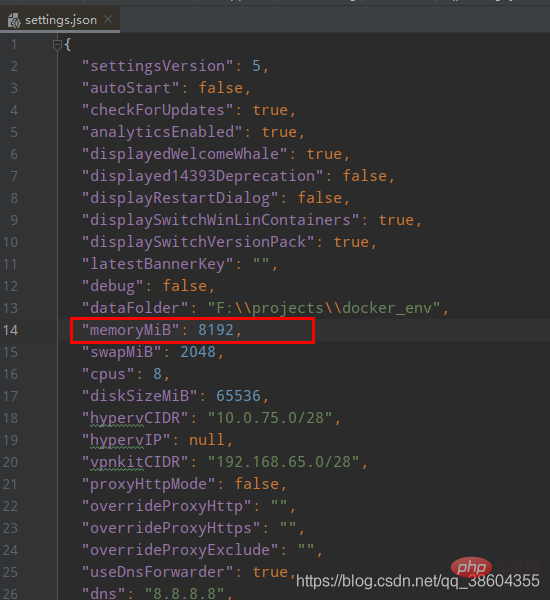How to solve the problem of insufficient memory in docker
Solution to insufficient docker memory: 1. Find "C:\Users\(username)\AppData\Roaming\Docker\settings.json"; 2. Edit the memoryMiB value; 3. Restart docker.

The operating environment of this article: Windows 7 system, docker desktop win version, Dell G3 computer.
How to solve the problem of insufficient docker memory?
Solution to docker dektop Not enough memory Insufficient RAM, Unable to start
After modifying RAM to 14Gb, the startup failed, prompting insufficient memory, unable to change from GUI settings, prompting The error is as follows
Problem
Unable to start at Docker.Core.Pipe.NamedPipeClient.d__5.MoveNext() --- End of stack trace from previous location where exception was thrown --- at System.Runtime.ExceptionServices.ExceptionDispatchInfo.Throw() at Docker.Core.Pipe.NamedPipeClient.Send(String action, Object[] parameters) at Docker.Actions.DoStart(SynchronizationContext syncCtx, Boolean showWelcomeWindow, Boolean executeAfterStartCleanup) at Docker.Actions.<>c__DisplayClass24_0.b__0() at Docker.ApiServices.TaskQueuing.TaskQueue.<>c__DisplayClass17_0.<.ctor>b__1() Not enough memory in the system to start the virtual machine DockerDesktopVM. Could not initialize memory: Ran out of memory (0x8007000E). 'DockerDesktopVM' failed to start. (Virtual machine ID E882D002-05C8-47C9-B90E-303A9C6E22EC) Not enough memory in the system to start the virtual machine DockerDesktopVM with ram size 2048 megabytes. (Virtual machine ID E882D002-05C8-47C9-B90E-303A9C6E22EC)
Solution
Out of memory - Issue since latest update · Issue #4368 · docker/for-win https://github.com/docker/for-win/issues/4368
The solution is that you can manually edit the settings.json file to reduce the VM memory. This is usually in
C:\Users\(username)\AppData\Roaming\Docker\settings.json. Edit the memoryMiB value.


Restart docker problem solved!
Recommended learning: "docker tutorial"
The above is the detailed content of How to solve the problem of insufficient memory in docker. For more information, please follow other related articles on the PHP Chinese website!

Hot AI Tools

Undresser.AI Undress
AI-powered app for creating realistic nude photos

AI Clothes Remover
Online AI tool for removing clothes from photos.

Undress AI Tool
Undress images for free

Clothoff.io
AI clothes remover

AI Hentai Generator
Generate AI Hentai for free.

Hot Article

Hot Tools

Notepad++7.3.1
Easy-to-use and free code editor

SublimeText3 Chinese version
Chinese version, very easy to use

Zend Studio 13.0.1
Powerful PHP integrated development environment

Dreamweaver CS6
Visual web development tools

SublimeText3 Mac version
God-level code editing software (SublimeText3)

Hot Topics
 1378
1378
 52
52
 How to change the docker image source in China
Apr 15, 2025 am 11:30 AM
How to change the docker image source in China
Apr 15, 2025 am 11:30 AM
You can switch to the domestic mirror source. The steps are as follows: 1. Edit the configuration file /etc/docker/daemon.json and add the mirror source address; 2. After saving and exiting, restart the Docker service sudo systemctl restart docker to improve the image download speed and stability.
 How to use docker desktop
Apr 15, 2025 am 11:45 AM
How to use docker desktop
Apr 15, 2025 am 11:45 AM
How to use Docker Desktop? Docker Desktop is a tool for running Docker containers on local machines. The steps to use include: 1. Install Docker Desktop; 2. Start Docker Desktop; 3. Create Docker image (using Dockerfile); 4. Build Docker image (using docker build); 5. Run Docker container (using docker run).
 How to read the docker version
Apr 15, 2025 am 11:51 AM
How to read the docker version
Apr 15, 2025 am 11:51 AM
To get the Docker version, you can perform the following steps: Run the Docker command "docker --version" to view the client and server versions. For Mac or Windows, you can also view version information through the Version tab of the Docker Desktop GUI or the About Docker Desktop menu.
 How to create a mirror in docker
Apr 15, 2025 am 11:27 AM
How to create a mirror in docker
Apr 15, 2025 am 11:27 AM
Steps to create a Docker image: Write a Dockerfile that contains the build instructions. Build the image in the terminal, using the docker build command. Tag the image and assign names and tags using the docker tag command.
 How to call docker lnmp
Apr 15, 2025 am 11:15 AM
How to call docker lnmp
Apr 15, 2025 am 11:15 AM
Docker LNMP container call steps: Run the container: docker run -d --name lnmp-container -p 80:80 -p 443:443 lnmp-stack to get the container IP: docker inspect lnmp-container | grep IPAddress access website: http://<Container IP>/index.phpSSH access: docker exec -it lnmp-container bash access MySQL: mysql -u roo
 How to save docker image
Apr 15, 2025 am 11:54 AM
How to save docker image
Apr 15, 2025 am 11:54 AM
To save the image in Docker, you can use the docker commit command to create a new image, containing the current state of the specified container, syntax: docker commit [Options] Container ID Image name. To save the image to the repository, you can use the docker push command, syntax: docker push image name [: tag]. To import saved images, you can use the docker pull command, syntax: docker pull image name [: tag].
 How to update the image of docker
Apr 15, 2025 pm 12:03 PM
How to update the image of docker
Apr 15, 2025 pm 12:03 PM
The steps to update a Docker image are as follows: Pull the latest image tag New image Delete the old image for a specific tag (optional) Restart the container (if needed)
 How to build a private repository by docker
Apr 15, 2025 am 11:06 AM
How to build a private repository by docker
Apr 15, 2025 am 11:06 AM
You can build Docker private repositories to securely store and manage container images, providing strict control and security. The steps include: creating a repository, granting access, deploying a repository, pushing an image, and pulling an image. Advantages include security, version control, reduced network traffic and customization.




